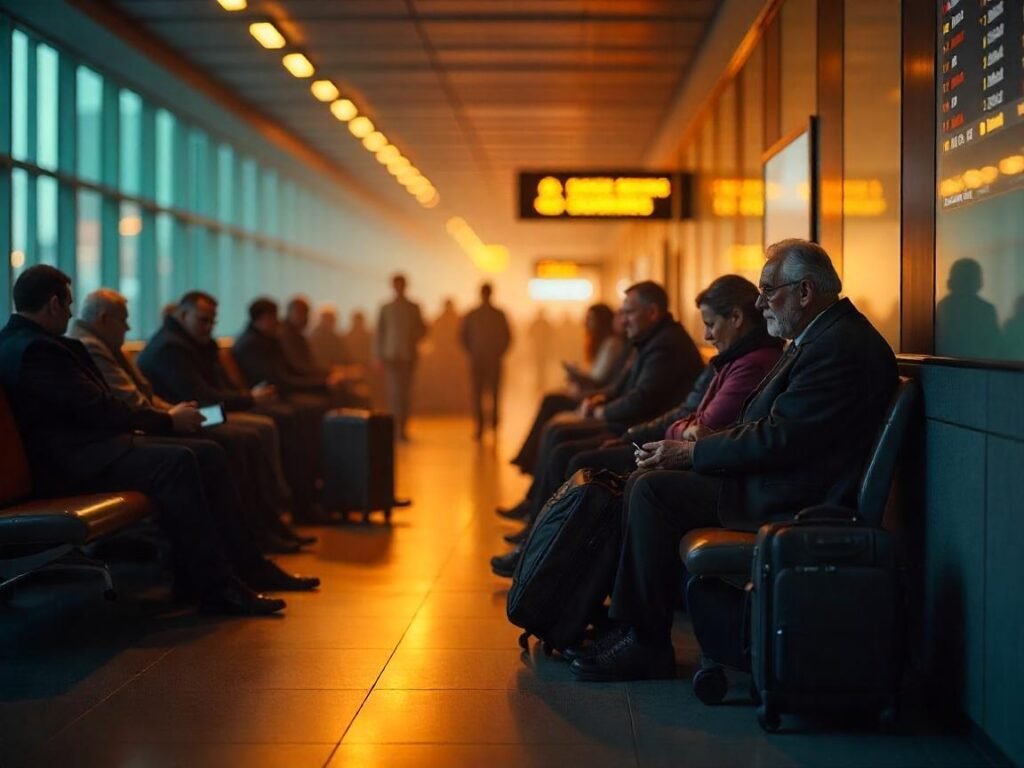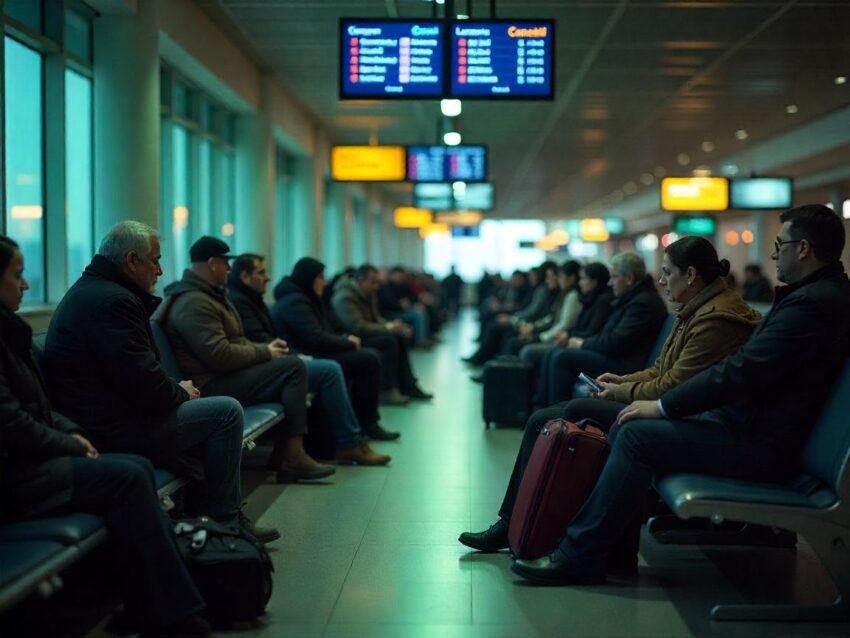
Wednesday, June 18, 2025

One hundred fifty thousand Israelis abroad—and many other tourists—are now caught in the middle of a spiraling crisis. With the Israel-Iran war escalating, airfields across the region have slammed shut, leaving chaos in their wake. The sudden air field closure has grounded thousands, shattering travel plans and turning tourism into a hotbed of tension. Families are stranded. Students can’t return. Honeymooners are trapped in limbo.
Meanwhile, the number of Israelis abroad continues to rise in news headlines, with nearly fifty thousand urgently trying to return to their homeland. But escape is no longer simple. With each passing hour, options vanish. Rescue flights are limited. Cruise ships are being scrambled. And the wait feels endless.
The Israel-Iran war has turned routine travel into a high-stakes gamble. Airports that once buzzed with tourists now stand in eerie silence. Across Europe, the Middle East, and Mediterranean hubs, stranded passengers stare at departure boards that never change. Their only hope? Emergency return flights.
Moreover, the air field closure has paralyzed normal operations. It’s no longer just a transportation issue—it’s a full-blown tourism crisis. Popular destinations like Larnaca, Athens, and Rome are overwhelmed. Hotels are booked out. Phone lines are jammed. Airline websites crash under the weight of desperation.
The tension is no longer confined to borders. It’s bleeding into hotel lobbies, ferry terminals, and stranded airports. And yet, despite the chaos, the drive to return home is stronger than ever. One hundred fifty thousand Israelis abroad feel the pull. So do many tourists from every corner of the globe.
This is not just another update. It’s a dramatic shift in global travel, triggered by conflict and intensified by panic. As tourism becomes a hotbed of tension, and as the Israel-Iran war stretches into its next volatile chapter, one question hangs in the air: how long until they all come home?
The answer—and the full update you need to know—is unfolding right now.
Israel’s skies remain shut to outbound travel, but a critical mission is now underway: bringing home tens of thousands of stranded Israeli citizens scattered across Europe and beyond. Following escalating conflict with Iran, and days of cancelled commercial flights, the Israeli government has approved special rescue flights to return its nationals.
This is not business as usual. It’s a highly coordinated, time-sensitive operation unfolding in real time. As airlines mobilize to bring people back, Israel’s tourism and transport sectors face an unprecedented moment of disruption.

150,000 Israelis Abroad, 50,000 Desperately Trying to Return
Since hostilities erupted last Friday, all commercial flights out of Israel have been grounded. Airspace closures created immediate chaos, halting travel plans and stranding an estimated 150,000 Israeli citizens overseas. Of those, nearly 50,000 are now actively seeking to return home.
Demand for rescue flights has skyrocketed. Within 90 minutes of opening a digital return portal, more than 60,000 people had already joined the virtual queue. From Europe’s airports to port cities in Cyprus, families, students, and tourists are urgently awaiting a path back.
El Al Takes the Lead on Rescue Efforts
Flag carrier El Al Airlines has taken the operational lead. On Wednesday, it will launch emergency return flights from several major European cities, including Larnaca, Athens, Rome, Milan, and Paris. These flights are exclusively for passengers holding cancelled El Al tickets, providing a lifeline to thousands stuck abroad.
However, no outbound flights from Israel are permitted yet. The focus is entirely on inbound relief, and all regular El Al flights remain cancelled until at least June 23. The airline has urged travelers to prepare for extended stays, arrange additional lodging, and exercise patience. Seats are limited, and the operation is being rolled out in stages.
Arkia and Israir Mobilize Additional Flights
Smaller Israeli airlines Arkia and Israir are also mobilizing. Arkia is organizing rescue flights from Karpathos (Greece), Larnaca (Cyprus), and Tivat (Montenegro)—targeting key hubs where many stranded Israelis have gathered.
Israir, meanwhile, is operating flights from Larnaca, Athens, and Varna (Bulgaria). It has cancelled all scheduled foreign and domestic flights through June 30, freeing up aircraft and crew for emergency use. These airlines are working in close coordination with security and aviation authorities to execute flights within approved time windows—even on weekends and high-security alert days.
The goal is clear: get as many people back as fast as safely possible.

Cyprus Becomes a Critical Evacuation Hub
Amid the crisis, Cyprus has emerged as a key evacuation point. The EU nation is geographically closest to Israel, with Larnaca Airport now acting as a staging ground for both flights and sea crossings.
Thousands have already gathered in Larnaca, hoping to board one of the limited rescue options. Flights from Cyprus to Tel Aviv typically take just 50 minutes, offering a vital corridor back to Israel. But with air capacity strained, not everyone can fly.
This is where Mano Maritime—an Israeli cruise company—has stepped in. The company’s Crown Iris ship, capable of carrying 2,000 passengers, will make at least two crossings between Cyprus and Haifa, Israel’s northern port city. Each sea journey takes around 15 hours, offering an alternative for those unable to board flights.
Rising Pressure on Hotels and Local Services
As thousands wait for transport, a secondary crisis is unfolding across hotels and travel agencies in cities like Athens, Larnaca, and Rome. Demand for accommodation has spiked. Tourists, families with children, and elderly passengers are being forced to extend stays unexpectedly, leading to surging costs and growing stress.
Travel assistance services are overwhelmed, and calls for local embassies to increase support are growing louder. Many travelers are seeking temporary housing, transportation to regional airports, and real-time updates from airlines—all while managing fear and uncertainty over escalating conflict back home.
No Timeline for Outbound Travel Resumption
At this stage, there is no indication of when normal outbound flights from Israel will resume. The country’s airspace remains closed due to ongoing security risks from the regional conflict. For now, the entire aviation strategy is focused on repatriation.
This pause on international departures has brought Israel’s travel industry—airlines, tour operators, hotels, and airports—to a standstill. Popular summer vacation plans have been disrupted. Local tourism-dependent economies in Israel, from Tel Aviv to Eilat, are bracing for fallout. The ripple effect will likely be felt well into July and beyond.
Strategic Response or Temporary Relief?
The scale and speed of the rescue mission highlight Israel’s logistical capabilities. However, aviation experts and security analysts caution that the situation remains fluid. If geopolitical tensions intensify, further restrictions could be imposed. Even these carefully coordinated rescue flights could be delayed, rerouted, or cancelled at short notice.
Moreover, the emotional toll on travelers—especially families separated across countries—is growing by the hour. Airlines and consulates face an immense responsibility: managing not just logistics, but fear, fatigue, and confusion.
As the Israel-Iran conflict deepens by the hour, forty thousand tourists currently in Israel find themselves trapped, confused, and desperate for clarity. Among them are Pride goers who had gathered in Tel Aviv for one of the world’s most vibrant LGBTQ+ celebrations, as well as young travelers on Birthright programs, families on summer holidays, and history lovers eager to walk ancient streets. But now, all of them face the same reality: they cannot leave.
What was supposed to be a once-in-a-lifetime adventure has turned into an unexpected waiting game. Flights are canceled. Borders are sealed. And airports are eerily silent.
A Sudden Halt to Everything
The transformation was swift. In a matter of hours, daily life in Israel flipped from festive to frantic. Just days ago, tourists were dancing in Tel Aviv, touring Jerusalem, and exploring the beaches of Eilat. But after Israel launched a missile strike on Iran on June 13, and Iran responded with counterattacks, the entire region plunged into chaos.
Israel shut its airspace. Tel Aviv’s Ben Gurion International Airport ceased commercial operations. And soon, closures followed across Tehran, Beirut, and other parts of the Middle East. International airlines rerouted or canceled flights. Passengers were left with little more than uncertainty and canceled itineraries.
Pride Goers in a State of Paralysis
The timing could not have been worse for the thousands who arrived in Tel Aviv to participate in the annual Pride events. Recognized as one of the most inclusive and electrifying Pride festivals in the world, Tel Aviv’s celebrations draw LGBTQ+ travelers from across the globe.
Now, those same visitors are trapped in hotel rooms, hostels, and Airbnbs—checking news headlines and embassy updates, unsure when they’ll be able to return home. Some are staying in central Tel Aviv, while others who had ventured to Jerusalem or the Negev are trying to return to urban centers in hopes of catching outbound flights—whenever those resume.
Birthright Trips Interrupted
Dozens of Birthright Israel groups—organized trips that bring young Jewish adults from around the world to connect with their heritage—were in the country when the conflict escalated. While program organizers acted swiftly to shelter and protect their groups, many participants remain in limbo.
Some Birthright tours have been suspended mid-way, while others are confined to secured locations. For these travelers, many of whom are visiting Israel for the first time, the experience has shifted dramatically from cultural discovery to personal safety planning.
Regional Shutdown Creates a Domino Effect
The airfield closures go far beyond Israel. Jordan, Lebanon, Iran, Syria, Iraq, and Russia have also seen widespread flight suspensions. Airlines across the Gulf—including Emirates, Etihad, flydubai, and Wizz Air Abu Dhabi—have paused routes. Even UAE airports, known for their global connectivity, are experiencing cascading delays and reroutes.
Cyprus, due to its proximity, has now become a temporary refuge and transit point for many stranded passengers. However, hotels in Larnaca and Nicosia are now nearly full, and the situation is becoming increasingly unsustainable.
Lebanon’s Fragile Tourism Sector on the Brink
Just to the north, Lebanon’s tourism industry is facing collapse. After years of economic struggle and gradual recovery, the Israel-Iran conflict has once again pushed the country into crisis. Cancellations are pouring in. Tour operators are suspending packages. And regions that depend on summer tourism income, like Byblos and Batroun, are bracing for devastating losses.
Safety concerns are keeping international travelers away, and even domestic tourism has slowed dramatically. Lebanese officials now fear that this summer may mirror the financial damage of the pandemic era—only with greater volatility and less global sympathy.
Global Fallout and Travel Advisories
In response to the rapidly deteriorating situation, the United States and Canada have both issued their highest-level travel warnings, advising citizens “Do Not Travel” to Iran and Israel. The US State Department has now placed Israel alongside Mexico, Venezuela, Haiti, Russia, Iran, Mali, and Belarus on its Level 4 list—signaling extreme risk due to conflict and terrorism threats.
This move has wide-reaching implications. Not only does it impact insurance and liability coverage for travelers, but it also affects flight operations, tour group decisions, and regional business confidence.
Airlines and Governments Scramble
Israeli carriers like El Al, Arkia, and Israir have begun operating emergency rescue flights from key hubs like Athens, Larnaca, and Rome—but only for returning citizens. Foreign tourists, however, must wait for their home governments or embassies to arrange safe departures.
Some countries are now mobilizing military or chartered aircraft to evacuate their nationals. Others are coordinating with cruise lines to move passengers via sea. Meanwhile, embassies are overwhelmed with calls, and overwhelmed travelers are running out of funds and patience.
What Tourists Should Know Now
If you’re currently in Israel, Lebanon, or anywhere in the region, stay informed through official embassy websites and government travel portals. Make sure your travel documents are ready and valid. Monitor email alerts from your airline and sign up for travel registries with your government if you haven’t already.
Be prepared for extended stays, and budget accordingly. Most importantly, avoid border zones, military areas, and public demonstrations.
The Bigger Picture
This moment marks more than just a temporary travel crisis. It’s a harsh reminder of how rapidly global mobility can collapse under the weight of geopolitics. And it underscores the increasing fragility of tourism in the Middle East—an area rich with culture, history, and beauty, but constantly tested by conflict.
For forty thousand tourists in Israel, including Pride goers and Birthright participants, the hope of going home still feels distant. And for tourism across the region, the road to recovery may now be longer—and more fragile—than anyone expected.
What Happens Next?
As rescue operations accelerate, Israel’s Ministry of Transportation and Civil Aviation Authority are expected to expand coordination with additional carriers. Talks are underway with international airlines and governments to potentially allow more charters or even military transport for vulnerable travelers.
Meanwhile, Israeli citizens abroad are urged to remain informed, register for repatriation, and avoid unapproved travel routes. Safety, not speed, remains the top priority.
A Defining Test for Israel’s Travel Sector
This crisis will be remembered as a defining moment for Israeli aviation. It has exposed both the fragility and the strength of global mobility in the face of conflict. As El Al, Arkia, Israir, and Mano Maritime continue to work around the clock, the travel world is watching—and learning.
For now, Israel’s skies remain mostly silent. But rescue flights are rising through that silence, one route at a time.





